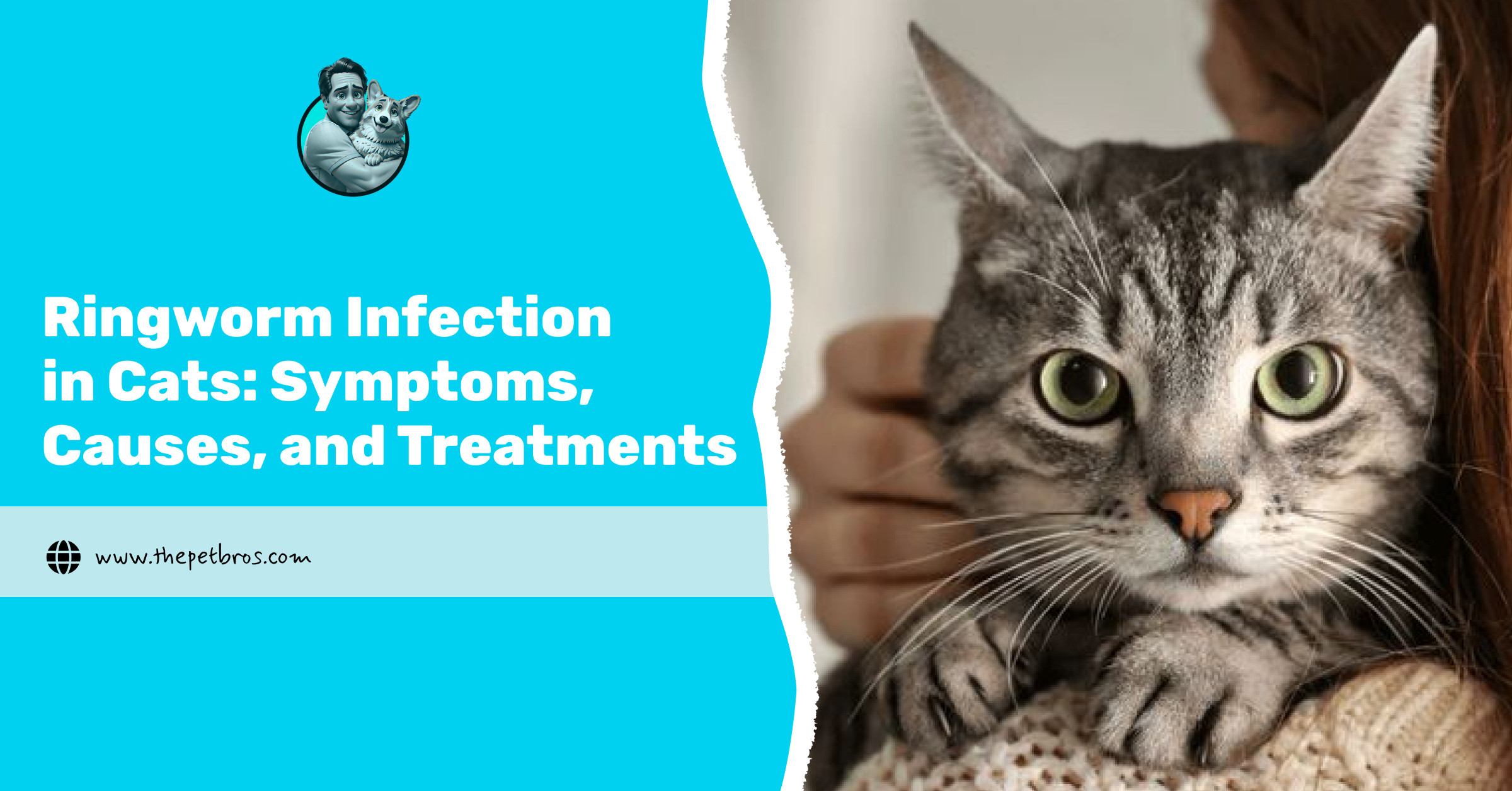If you have ever spotted a patch of missing fur on your cat and thought, “Oh no, what’s going on here?”, you’re not alone. The most common culprit behind sudden bald spots and scaly skin is a ringworm infection in cats.
Now, interestingly, despite the name, there are no actual worms involved. It’s a fungal skin condition that feeds on your cat’s fur, skin, and sometimes even their claws. The tricky part is that it’s contagious, and it can spread not only to other pets but also to humans.
When discussing ringworm in cats, it’s helpful to understand that the symptoms don’t always appear the same. Some cats develop the classic round, patchy bald spots. Others may only have a bit of flaky dandruff hidden deep in their coat. In this guide, we’ll walk you through what ringworm infection in cats looks like, how your cat may catch it, why it spreads so easily, and what you can do to protect both your feline friend and your household.
Let’s get right into it!
How Do Cats Get Ringworm Infection?
Here’s the sneaky bit about ringworm: it doesn’t actually need much of an invitation to set up camp on your cat. This fungal infection is ridiculously contagious. It spreads through direct contact with an infected animal, a person, or even everyday objects like bedding, grooming brushes, carpets, or that cosy chair your cat loves snoring off on. The spores are stubborn little things, too. They can survive in the environment for up to 18 months. And this is why ringworm can keep coming back if your home isn’t given a proper deep clean.
Kittens, long-haired cats, and those with weaker immune systems are the most vulnerable. Kittens are like toddlers with sticky fingers, always curious, playful, and not exactly the best at avoiding germs. As for the long-haired cats? Their thick coats make the perfect hiding place for fungal spores, which means the infection can spread before you’ve even noticed.
In short, cats can catch ringworm from almost anywhere; a quick wrestle with another feline or a sneaky nap on a contaminated blanket can be a cause.
Symptoms of Ringworm Infection in Cats
Ringworm infection in cats doesn’t always make itself obvious. Some cats can appear perfectly fine while quietly harbouring the fungus; talk about being a stealth carrier. It’s common knowledge that deciphering the signs cats give can be challenging. So when the infection does show itself, there are a few tell-tale signs you’ll want to keep an eye out for.
The classic giveaway is those round, patchy bald spots where the fur has gone missing and the skin underneath looks scaly or crusty. These patches often appear on the head, ears, chest, forelegs, or along the back, essentially all the prime scratching and rubbing zones.
Other signs include:
- A dandruff-like flakiness in the coat (obviously not the glamorous kind).
- Brittle hairs that snap off easily.
- Red, sore, or thickened patches of skin.
- In more stubborn cases, the infection can even reach the claws, leaving them rough, scaly, or oddly shaped.
It’s worth remembering that not all cats read the rule book. Some only get a sprinkling of flaky skin, while others might go full-on patchy. And just to keep things interesting, long-haired cats can hide symptoms completely under their floof, spreading spores around the house without you noticing a thing. This is why spotting the early signs of a ringworm infection in cats is so important, even if they don’t look very dramatic at first.
If you spot any of these signs, don’t ignore them. A bit of hair loss might look harmless, but when a ringworm is involved, early action saves you and your cat a whole lot of hassle.
How Do Vets Diagnose Ringworm Infection in Cats
- Wood’s Lamp Test: A special ultraviolet light can make some strains of ringworm glow a yellow-green under the fur. It looks a bit like your cat is heading into a nightclub, but here’s the catch: not every case of ringworm lights up, so vets can’t rely on this test alone.
- Fungal Culture: This is the most reliable way to confirm a ringworm infection in cats. Here, a veterinarian collects hairs or skin scrapings and sends them to a laboratory to determine if the fungus is present. It’s not instant, though results can take anywhere from a few days to several weeks. Think of it like planting seeds in soil: sometimes you see sprouts quickly, other times you’re waiting ages for something to show.
Because hair loss and skin problems in cats can be caused by all sorts of things, such as allergies, mites, stress, or even heart disease, your vet may also recommend additional tests to rule out other conditions. This ensures you’re not treating the wrong issue and helps the vet confirm that ringworm really is the culprit.
The bottom line is, if your cat is losing fur or has suspicious scaly patches, a vet check is a must. It eliminates the guesswork and ensures you begin the right treatment as soon as possible.
Ringworm Infection in Cats Treatment
Treating ringworm isn’t a one-size-fits-all job; it usually takes a mix of medication and some serious house cleaning (yes, sadly, that bit’s non-negotiable). Your vet will guide you based on how widespread the infection is, but here are the main approaches:
- Topical therapy: This means creams, ointments, medicated shampoos, or the rather old-school but effective lime sulphur dips. These are applied regularly over several weeks to knock the fungus back where it belongs, out of your cat’s coat.
- Oral therapy: For more stubborn or widespread cases, your cat might need antifungal drugs such as itraconazole or terbinafine. These are usually given for at least six weeks, and sometimes longer, depending on how your cat responds.
- Environmental cleaning: This aspect is often overlooked, but it’s just as important as the medication. Ringworm spores can live for months in your home, so regular vacuuming, mopping, and disinfecting with a diluted bleach solution are key. In some cases, bedding, toys, and grooming tools may need to be replaced to avoid reinfection.
It might sound like a lot, but treating ringworm properly is worth the effort. Because it’s so contagious, tackling both your cat and their environment is the only way to make sure it doesn’t sneak back. A bit of patience, regular cleaning, and sticking to the treatment plan will have your cat on the mend and your home fungus-free.
If you’d like to learn more about the different treatment options, take a look at our article on Ringworm Infection in Cats Treatment.
Conclusion
Ringworm infection in cats might sound scary, but with the right care, it’s more of an inconvenience than a catastrophe. Spotting the signs early, getting a proper diagnosis, making sure they are not spreading it as they follow you around and following through with treatment (plus that all-important home cleanup) will help keep the infection from spreading and aid your cat’s recovery.
Frequently Asked Questions
How do vets treat ringworm in cats?
Most cats need a mix of oral antifungal drugs, topical creams or shampoos, and strict home cleaning.
How to treat ringworm in cats without a vet?
Home remedies are not effective. Ringworm treatment requires prescription medication, so always consult a vet.
Can I touch my cat if it has ringworm?
Yes, but wear gloves and wash your hands after. Ringworm can spread to humans.
Why do cats get ringworm?
Ringworm spreads through contact with infected animals or contaminated objects. Kittens and long-haired cats are more at risk.
How to tell if a cat has ringworm?
Look for circular patches of hair loss, scaly skin, brittle hair, or rough claws. A vet can confirm with lab tests.
Do I have to disinfect my house if my cat has ringworm?
Yes. Spores can survive up to 18 months, so vacuuming, mopping, and disinfecting are essential to prevent reinfection.














